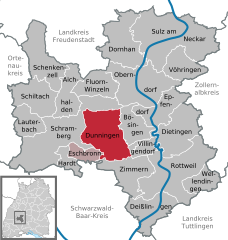Dunningen
Dunningen is located at the centre of the administrative district of Rottweil in the south western part of Baden-Wuerttemberg, Germany.
The village is located in the shell limestone area between the Black Forest and the Swabian Alps on a strip of open country that crosses the district from north to south and that is mainly used for agriculture.
It is located on the eastern slope of the central part of the Black Forest, which borders on the Oberen Gäuen in the west.
Dunningen shares the municipal boundaries with Waldmössingen, Beffendorf, Bösingen, Villingendorf, Hochwald, Zimmerm ob Rottweil, Eschbronn and Sulgen.
The district of Dunningen includes the village itself, the villers Auf der Stampfe and Frohnhof, the farms Eichhof, Gifizenmoos, Stittholz, Staudenrain and Beckenwäldle and the dwelling place Hindenburg.
After the Principal Decree of the Imperial Deputation in 1803, the village became part of Württemberg and was integrated into the newly created city district of Rottweil.
In the course of the administrative reform that took place in Baden-Wurttemberg in the seventies, the municipalities of Lackendorf and Seedorf were incorporated into Dunningen, on 1 August 1972 and 1 January 1974 respectively.
Maier was a politician of the Social Democratic Party of Germany, during the times of the German Empire and the Weimar Republic, and became the Home Secretary of Baden some years later.
His most famous work shows Susette Gontard, the wife of a Frankfurt banker, who is known in literary history as Hölderlin's Diotima.


